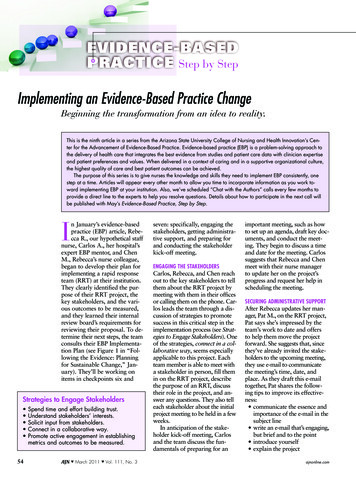
Transcription
Center for Surveillance, Epidemiology,and Laboratory ServicesEvidence-Based Practice: What It Is and Why It MattersW. David Dotson, PhDOffice of Public Health GenomicsCenters for Disease Control and Prevention
OUTLINE What is evidence-based practice?The concept of evidence, and its role in decision makingChallenges in assessing evidence in geneticsA deeper dive into some tools of the tradeExamples of understanding evidence in the “real world”Why does evidence-based practice matter?Resources
What is Evidence-Based Practice?
Evidence-Based Practice (EBP)“Evidence based medicine is the conscientious, explicit, and judicious use ofcurrent best evidence in making decisions about the care of individual patients.The practice of evidence based medicine means integrating individual clinicalexpertise with the best available external clinical evidence from systematic research.”Sackett et al., omehttps://www.bmj.com/content/312/7023/71
Fundamental Tenets of Evidence-Based Medicine (EBM) Evidence hierarchy as a guide in clinical decision making Evidence, on its own, is never sufficient to make aclinical decisionGuyatt et al. User’s Guides to the Medical Literature. 2nd Edn. 2008
Fundamental Tenets of Evidence-Based Medicine (EBM)cont. Awareness of best available evidence required for bestdecision making EBM helps us understand how trustworthy evidence is Evidence, on its own, is never sufficient to make aclinical decisionGuyatt et al. User’s Guides to the Medical Literature. 3rd Edn. 2015
Evidence and Decision Making
Evidence Hierarchieslibraryguides.umassmed.edu/EBM
The Randomized Controlled Trialbmj.com/content/327/7429/1459
A New Hierarchy?M Hassan Murad et al. Evid Based Med 2016;21:125-127 2016 by BMJ Publishing Group Ltd
Systematic Reviews to linical-Practice-Guidelines-We-Can-Trust.aspx
Steps in Systematic Review Identify question(s)Create protocolDefine inclusion/exclusion criteriaSystematic literature searchSelect studies for inclusionExtract dataAssess quality of evidenceEvaluate risk of biasSynthesize results
Systematic Literature Search Flowncbi.nlm.nih.gov/pubmed/28295040
Assessing Evidence in Genetics
Organizing the Systematic Review Design and organization of systematic reviews can beespecially challenging for genetic or genomic-basedtopics Often need to bring together information on– Analytic validity– Clinical validity– Clinical utility– Ethical, legal, and social implications– Other contextual issues
Analytic Validity Ability of test to accurately and reliably detect thegenotype of ract/2011/07000/An Introduction to Assessing Genomic Screening and.4.aspx
Clinical Validity Ability of test to detect or predict the clinical disorder(or phenotype) of ract/2011/07000/An Introduction to Assessing Genomic Screening and.4.aspx
Clinical Utility Influence of test on health outcomes; risks vs benefitsof introducing test in 011/07000/An Introduction to Assessing Genomic Screening and.4.aspx
ACCEModelcdc.gov/genomics/gtesting/acce/
Example Analytic FrameworkOverarching QuestionAnalytic ValidityAdults, MajorDepression,SSRIsCYP450GenotypeClinical TreatmentDecisionsClinical UtilityHealthOutcomesPredictAdverseEventsModified from ncbi.nlm.nih.gov/pmc/articles/PMC2743609/
Clinical UtilityModified from ncbi.nlm.nih.gov/pmc/articles/PMC2743609/
Clinical ValidityModified from ncbi.nlm.nih.gov/pmc/articles/PMC2743609/
Analytic ValidityModified from ncbi.nlm.nih.gov/pmc/articles/PMC2743609/
Meta-Analysis
Systematic Review vs Meta-Analysis
Objectives of Meta-AnalysisSummarize results from individual studiesAnalyze differences in results among studiesOvercome small sample sizes of individual studies todetect effects of interestanalyze end points that require larger sample sizesDetermine if new studies are needed to investigate anissue Generate new hypotheses for future studies Modified from: http://www.ccjm.org/uploads/media/media bfab903 431.pdf
Effect 444174/pdf/i1949-8357-4-3-279.pdf
Forest PlotsA.B.C.Modified from 91.12489/pdf
Checking for Potential BiasA. Symmetric Funnel PlotB. Asymmetric Funnel 474302/
Sources of Funnel Plot 3
Critically Appraising a Meta-Analysis Are the study results valid? Was a focused and clearly described research questionpresented? Was the literature search both systematic andreproducible? Was there a systematic study selection process? Characteristics of included studies were provided? Was there a quality assessment of included MC3004078/
Critically Appraising a Meta-Analysis (continued) Statistical methods for combining studies wereadequately reported? How heterogeneous were the pooled studies? Was there an assessment of publication bias? What were the main results of the study? What were the practical significance and statisticalsignificance of the main results? What is the likelihoodthat these results were due to chance? Are the results generalizable? To whom are icles/PMC3004078/
An Evidence Heuristic
An Evidence Heuristicncbi.nlm.nih.gov/pmc/articles/PMC4689130/
Levels of Evidence Tier 1 –base of synthesized evidence supportingimplementation in practice Tier 2 – synthesized evidence not adequate to supportroutine implantation in practice; may still be useful inselective use strategies/decision making Tier 3 – synthesized evidence supportingrecommendations against use, or no relevantsynthesized evidencencbi.nlm.nih.gov/pmc/articles/PMC4689130/
Association Rulesncbi.nlm.nih.gov/pmc/articles/PMC4689130/
What is Practical in Public action
ExamplesUnderstanding Evidence in the “Real World”
Example: Importance of Understanding the Questionsncbi.nlm.nih.gov/pubmed/26979548
Some Limitations Pooled the results of small studies, with separate metaanalyses for– Diet– Smoking cessation– Physical activity What about differences between the genetic ealthy-behavior-finds-review-of-research/
Example: Conflicting ResultsModified from ncbi.nlm.nih.gov/pubmed/23670120
Why Does EBP Matter?
Evidence-Based Practice Enables evidence-informed, standardized protocols, not“cookbook” health care Affords transparent pathways to improving– Diagnosis– Treatment– Health outcomes
Some Resources
Sources of Systematic Reviews Advisory Committee on Heritable Disorders inNewborns and Children Agency for Healthcare Research & Quality (AHRQ) Cochrane Collaboration Health Technology Assessment International (HTAi)
Sources of Practice Guidelines American College of Medical Genetics and Genomics(ACMG) American College of Obstetricians and Gynecologists(ACOG) National Society of Genetic Counselors (NSGC) US Preventive Services Task Force (USPSTF)
Thank you!W. David Dotson, PhDOffice of Public Health GenomicsCenters for Disease Control and Preventionwdotson@cdc.govFor more information, contact CDC1-800-CDC-INFO (232-4636)TTY: 1-888-232-6348 www.cdc.govThe findings and conclusions in this report are those of the authors and do not necessarilyrepresent the official position of the Centers for Disease Control and Prevention.
“Evidence based medicine is the conscientious, explicit, and judicious use of current best evidence in making decisions about the care of individual patients. The practice of evidence based medicine means integrating individual clinical . expertise with the best available external clini





![project2 Encase.pptx [Read-Only]](/img/12/project2-encase.jpg)




